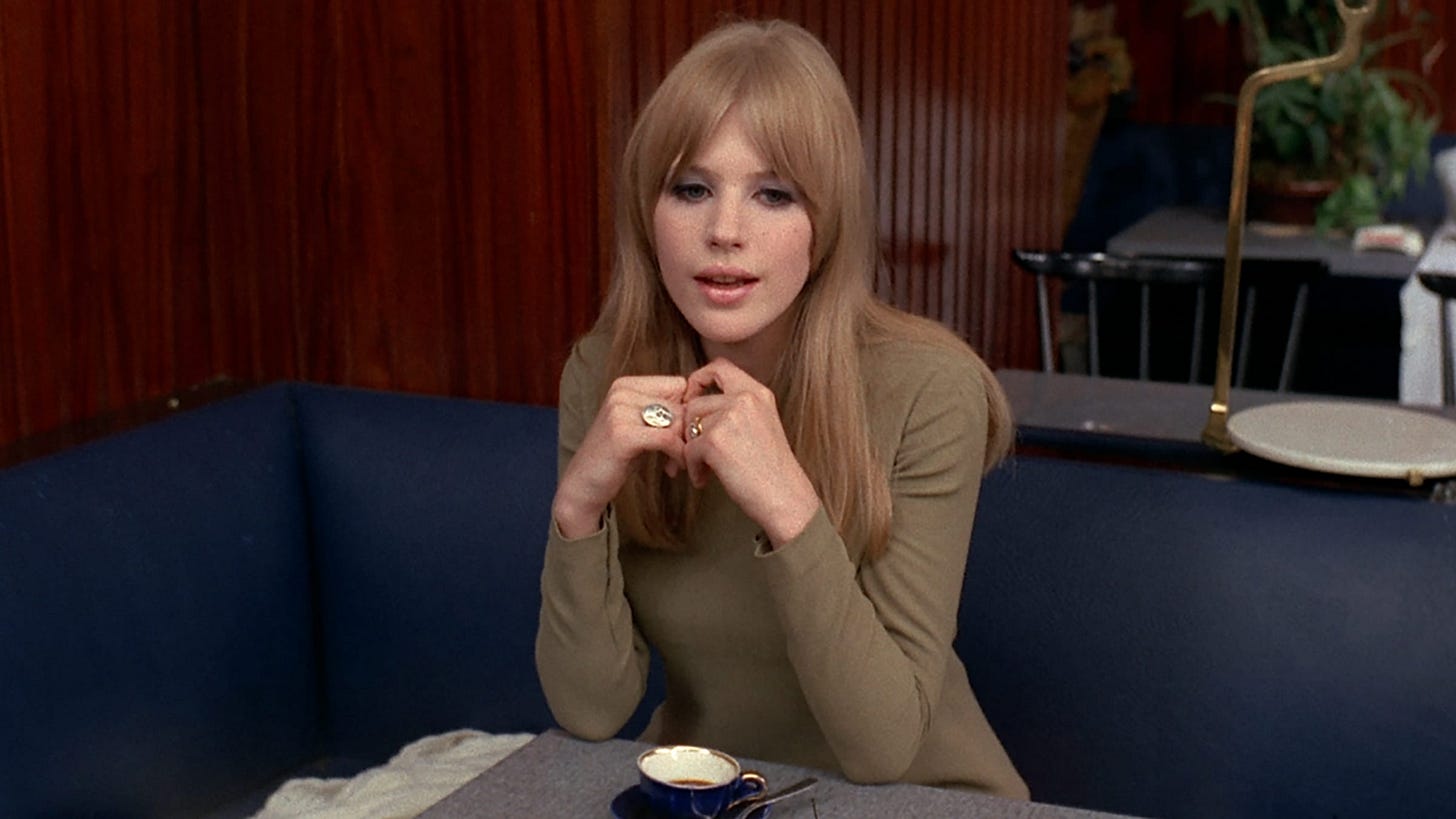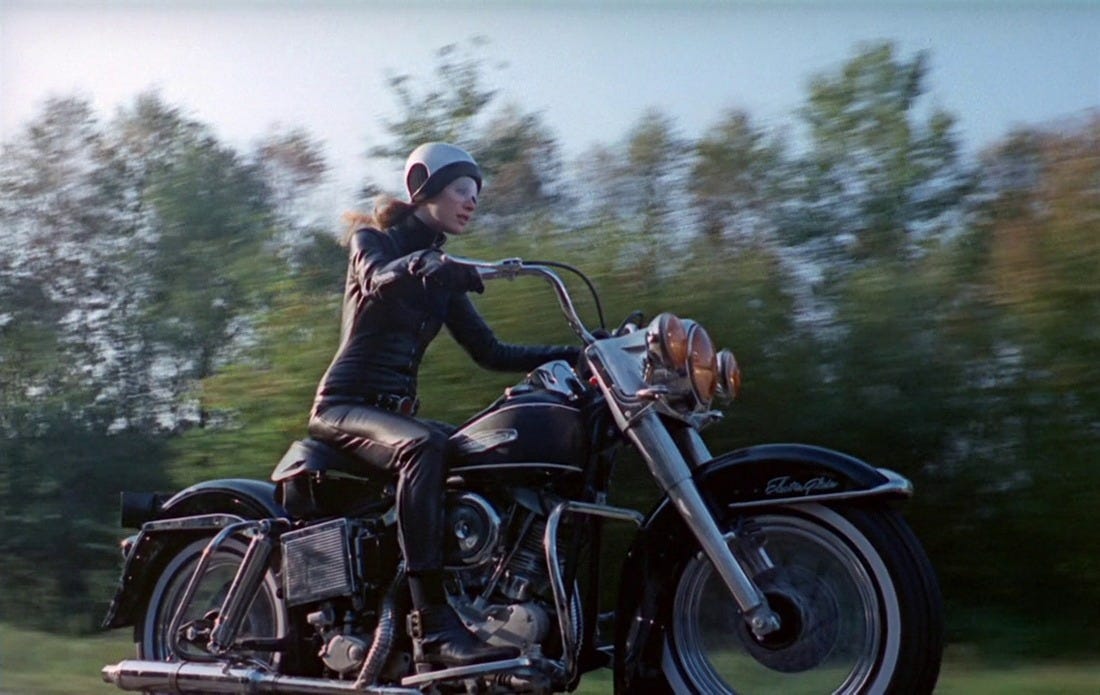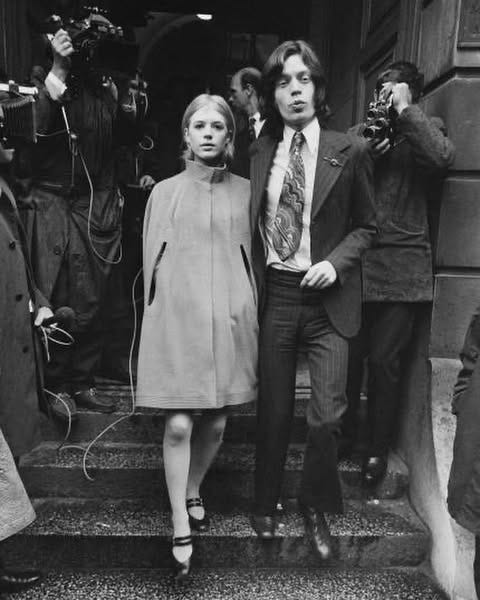Marianne Faithfull's beautiful, wretched excess
RIP to the singer, poet, sage, survivor, and (of course) style icon who lived a thousand lives with uncompromising flair. Plus: the women who made the Rolling Stones
Marianne Faithfull — singer, actress, sage, poet, survivor — died on Thursday, at 78 years old. She lived what seemed like a thousand lives, extravagantly, largely, with uncompromising style and flair.
Faithfull was addicted to romance, to drama, to adventure. Or maybe she was fated to a life full of them. Her mother, Eva, was the Baroness Erisso; her father, a spy for British intelligence during World War II. After her parents divorced, little Marianne — like the heroine of a fairy tale — moved to a poor section of Reading, England, with her mother and grandmother. They were, Faithfull wrote in her glorious 1994 autobiography Faithfull, “penniless.” The baroness toiled away in menial jobs as she fed her daughter fantastical stories of their noble ancestors and dressed her in embroidered dresses with lace cuffs and collars. “My childhood was filled with embarrassing incidents born of delusion of grandeur on my mother’s part,” Faithfull wrote. Eva was “raising a princess on the back streets of Reading.”
Faithfull, no surprise, was a misfit at her convent school. She spent her days reading Jane Austen instead of playing sports with her classmates. But she did fall in love with theater there. She actually wanted to be an actress … but when she was 17 the manager of the Rolling Stones, Andrew Loog Oldham, saw her at a party — “an angel in big tits,” as he later described her — asked her boyfriend sitting next to her if she could sing (“I think she can?”) and signed her on the spot, commissioning Mick Jagger and Keith Richards to write a song for her asap.
That song was “As Tears Go By,” and it turned Faithfull into a star.

To modern eyes, Faithfull epitomizes the 1960s, yet in 1964 — when “As Tears Go By” hit — her appearance, her aura, was radical. Back then, the “dolly bird” look was all the rage in London: false eyelashes, “loads of mascara,” and “fancy party frocks,” as Faithfull described it in her autobiography. But Faithfull eschewed heavy makeup, wore her boyfriend’s shirts tucked into blue jeans, and preferred dresses with voluminous sleeves that made her look like a doomed romantic heroine. Lady of Shalott vibes. She left her mother’s house in Redding and went on tour, lugging volumes of Yeats and Keats to read on the bus, despite knowing she was never going back to school. Her fate was sealed: she would become a star. A princess, like her mother had cultivated her to be, but a tragic one, whose ethereal beauty would cause her pain and suffering.
And unlike Snow White or Rapunzel or the other fairy princesses punished for their looks, there was no prince charming at the end of Faithfull’s story. She would need to save herself.

Faithfull did not particularly care for fame — indeed, she was embarrassed by it — but she enjoyed being able to buy things, so many things, as well as the sort of exhilarating decadence “dropping several thousand pounds in 45 minutes” gave her. She has this incredible description of the ruinous allure of shopping in Faithfull. At this point, she’s married with an infant son, and has reconnected with the Rolling Stones and befriended guitarist Brian Jones and his imperious model girlfriend Anita Pallenberg.
It’s the summer of 1966, but for me it is Year One. I’ve been adopted by Brian and Anita, and their flat in Courtfield Road has become my second home. I’m trying to make a beeline there, but everywhere I look there’s some insane distraction. Bengalis selling scarves with magic signs on them, two buskers in Elizabethan rags playing hurdy-gurdies and tiny drums, a couple of hustlers selling knock-offs of those big plastic Biba bracelets. God, will you look at David Bailey with the little tart on his arm! Harrods looming up like a great liner, and a little farther on, Walton Street with dozens of seductive boutiques. Shop windows filled with bright Smarty colors. Miniskirts, sequined gowns, slinky thigh-high boots, brass earrings, boas. Everything sparkling, modern, dazzling.
Her new husband wasn’t too thrilled about her new lifestyle and spending habits, but then again, she lamented, “he never has been able to grasp the beauty of wretched excess, the poor darling.”
The beauty of wretched excess. This was Faithfull’s raison d'être, her credo, her way of life.
She slept with three of the Stones and eventually went with frontman Mick (though she thought he was the lamest one), and the two became the king and queen of London’s rock scene. The photos of them together are still electrifying: Marianne in a knee-length cape and double-strapped mary janes and Mick in a mod-ish suit, Marianne in a luxurious velvet embroidered coat and Mick in a sparkly jacket and top hat, the pair in matching white separates with Marianne sporting her mini heart-shaped sunglasses. Marianne in particular could wear any kind of style — sexy leather jumpsuits, Swinging 60s minis, bohemian layers topped off with floppy hats and feathered boas, tailored suits and ties — and make it look utterly her. She once dressed like a nun for a performance with David Bowie, and she looked so cool and elegant and kinky all at once.
She imbued everything she wore with her beautiful wretched excess.
Faithfull’s time in the limelight nearly broke her. Mick was maybe not physically abusive, but he was casually cruel, stealing her looks, her ideas, her writing, her interests, and making her question her worth as an artist and partner. (She wrote the lyrics for the Stones’ song “Sister Morphine” and even recorded it before them, but they did not credit her as a songwriter when they released it and turned it into a mega hit.) She nearly ODed several times, had three suicide attempts, and suffered from anorexia. After breaking up with Mick, in 1970, she lived for two years “on a wall” on a former bomb site in Soho, shooting heroin and dropping out of society. The last time she went to visit her mother’s house (before getting clean), she cut her face with a razor blade “in a fit of cocaine psychosis”:
I developed a violent hatred of my appearance, of my face, of beauty itself. Didn’t it get me into all this trouble in the first place? Beauty was a curse. It stood between me and who I was. It prevented people from seeing what was really of value if anything!
And yet … she carried on.
I think part of the reason for her survival (aside from luck) was that Faithfull did not wallow in shame or pity when she lived on the street — quite the opposite. “For me, being a junkie was an honorable life,” she wrote. “It was total anonymity, something I hadn’t known since I was 17.” It also gave her a community of people who actually looked out for her (not just giving her drugs, but food, blankets, whatever she needed to get her through another night on the street) — rather than just used her for fame or money. She wrote:
When I left Mick I thought humanity was the worst thing ever to have plagued the planet. It was out on the street that I began to see how kind and compassionate people could be. It was junkies and winos on the street who restored to me my faith in humanity. People think that my time with Mick was this glorious moment in my life, but not for me. I knew that the life we were leading wasn’t reality.
Eventually, a former producer found her sitting on her wall and asked her to cut a record. Her voice was no longer the sweet soprano of an angel but the world-weary, cracked and damaged alto of a woman who had seen things. In 1979, she released her extraordinary comeback album, Broken English, a new wave, blues-inflected masterpiece that made use of her new voice and persona. She wasn’t so much a fallen angel but a phoenix.
Faithfull went on to cut many many other great records, to inspire legions of other performers, from Courtney Love and Cat Power to Nick Cave and PJ Harvey, to chart her own path and style. She survived breast cancer in 2006 and nearly died from COVID in 2020. Yet in 2021, she was promoting another album (the spoken-word She Walks in Beauty), posing for The New York Times in a fur coat, leather gloves, and a mustard-colored silk muumuu. A legend.
During that interview, she admitted “in her admirably no-nonsense way” that she didn’t necessarily want to chat a reporter at that moment, but that, per the reporter Lindsay Zoladz, she found it “vivifying to talk about her life, her art, her past and future.”
“It’s good for me to remember who I really am, not just an old sick person,” she told Zoladz.
“Of course,” Zoladz replied. “You’re Marianne Faithfull, damn it!”
She mulled it over for a long moment. “It’s true, I am.” Then, with an unexpected surge of strength, like a hammer’s blow, she added, “Damn it.”
***
These Women Behind the Rolling Stones Were Cooler Than the Band

A few years ago, I wrote about Elizabeth Winder’s book “Parachute Women: Marianne Faithfull, Marsha Hunt, Bianca Jagger, Anita Pallenberg, and the Women Behind the Rolling Stones” for The New York Post. (The book is fabulous, like Winder’s previous books on Sylvia Plath and Marilyn Monroe, and I highly recommend it.) Since the piece delves in Faithfull’s relationship with Mick Jagger a bit more than above, and her influence on his work, I thought I would share a version of my story here:
Anita Pallenberg didn’t look like the average Rolling Stones groupie. Lanky and blonde, in a short fur jacket, miniskirt, and Roman gladiator sandals, she exuded a kind of raw sexuality that made the other girls in their orbit look like shrinking violets.
The German-Italian actress had modeled in Italy, hung out with Andy Warhol’s crew in New York City and bedded loads of men and women. She spoke about five languages and sported her under-eye circles like badges of honor.
Yet here she was, hovering at the door of the Stones’ dressing room.
“Vant to smoke a joint?” she dared them.
Before that night in September 1965, the Stones had never done drugs. Mick Jagger and Keith Richards had barely slept with anyone. They didn’t even drink. Only Brian Jones partied like a rocker, swigging brandy and fathering a string of illegitimate children. Yet even he still wore pants bought by his mom.
The Stones, at that point, “were not much more than unbrushed Beatles dressed in play-clothes,” writes Elizabeth Winder in her new book, Parachute Women, about the women behind the world’s most storied, most mythic rock band. “Yet in the span of a few short years, they’d be the unassailable pirates that we know today — the world’s first rock stars.”
Winder credits four women with catapulting The Stones into gods, of giving them “all their strut and glamour.” These ladies — artists and individuals in their own right — were “the real rebels, progressives and contrarians,” she argues.
“The Rolling Stones may have risen to fame as rock’s favorite outlaws but only under the tutelage of these remarkable women,” Winder writes.
Anita Pallenberg
Only Brian Jones accepted Pallenberg’s invitation to toke up that fateful evening in 1965. They spent the night in Brian’s hotel room smoking and talking. The next day, she accompanied The Stones on their next tour stop in Berlin.
Soon, Brian and Anita were the 1960s’ hottest, most dangerous couple. She introduced him to S&M, LSD and the occult — they tore through London in his black Rolls-Royce with the license plate DD666 (for “Devil’s Disciple”). She dressed him in her clothes, too.
Actually, all the Stones pilfered from her wardrobe: Brian, her velveteen trousers and silk scarves; Keith, her skull rings and Victorian mourning pins; Mick, her floppy fedoras and feather boas. She didn’t treat them like demigods, either.
“Crap,” she pronounced when Jagger played her a demo of the louche “Stray Cat Blues,” adding, “The vocals are mixed too high and the bass isn’t loud enough.” Jagger ran to the studio and had it remixed right away.
“Unlike starstruck groupies who felt honored to be chosen by the Stones as consorts, Anita was nonchalant, like she was doing them a favor, like she deserved their worship and adulation,” Winder writes. “It was Anita who was the star, it was Anita everyone came to see in Brian’s flat on Courtfield Road — not Brian, not Keith, and not even Mick.”
That made Brian, and Mick, jealous. Brian began beating her. Mick began resenting her. There’s a reason why she ended up with the more pliant, more easygoing Richards. Still, even he proved to be too weak for her.
Marianne Faithfull
Marianne Faithfull thought The Rolling Stones were just “awful”: “spotty schoolboys,” she called them.
She was 17 years old, a classically trained singer and actress who had just escaped from convent school, when The Stones’ manager had noticed her angelic looks at a party. He asked the band’s singer Mick Jagger and guitarist Keith Richards to write something for her, but the duo barely looked at her during their recording session.
“It was like I didn’t exist,” she wrote later.
The song they recorded that day, “As Tears Go By,” however, launched Faithfull’s pop music career. She reconnected with the songwriters a couple years later, while escaping a disappointing marriage.
Faithfull began spending time at Brian’s and Anita’s place, where Keith also hung about. The trio would rag on Mick, who was way too straightlaced to drop acid and mostly came by to monitor his more reckless bandmates.
But after a gig in Bristol, Marianne spent an evening strolling through the grass with The Stones frontman, discussing King Arthur. When they got back to his hotel room, he knelt by her feet, unlaced her dew-damp boots, and put them by the heater to dry.
“I was completely moved by his kindness,” Faithfull said. “And then we made love.”
Mick kicked his long-suffering mod girlfriend, model Chrissie Shrimpton, out of his house and installed Marianne.
Faithfull was far more worldly than Mick. She encouraged him to drop acid, introduced him to Russian literature and took him to the ballet for the first time.
“One of the things Mick liked about me was the way we discussed his ideas for songs,” she later said. “I was more educated than he was. I was very good with words.”
Marianne’s copy of Bulgakov “The Master and Margarita” — which she told Mick to read — inspired “Sympathy for the Devil.” The Stones’ lascivious lips-and-tongue logo came from the shocking ballet “Paradise Lost,” which Marianne took him to see. After Marianne starred in Chekhov’s play “Three Sisters” at the Old Vic, Jagger announced he wanted to act as well. Marianne coached him extensively for his first movie role, in the sordid 1968 flick “Performance,” opposite Pallenberg.
Marianne liked helping him. Everything Jagger did seemed more important than her own stalling career, singing pop ditties that she hated, acting in movies that exploited her fame and body. Collaborating with her boyfriend “made me feel that I was doing something very creative,” she later said. “I think women can slip into that. Living through a man.”
She wasn’t as thrilled when The Stones recorded “Sister Morphine” for their 1971 album Sticky Fingers. Faithfull had written the lyrics based on a riff she heard Jagger fiddling with years before. She even recorded it herself in 1969, but her record company quickly pulled it from the shelves due to its salacious drug content.
So Jagger took it for his band. They didn’t even credit her as a songwriter.
Marsha Hunt
While Mick was in a relationship with Marianne, he began pursuing Marsha Hunt.
Born in West Philadelphia, Marsha never saw Jagger as anything more than a friend with benefits. She had dropped out of Berkeley to go to London to pursue a music career. By the time she had met Mick, she had opened for The Kinks and Jimi Hendrix, slept with glam rocker and T. Rex frontman Marc Bolan, and starred in the 1968 West End production of “Hair,” shedding her clothes and proudly displaying her natural Afro.
She found Mick charming and easy to talk to, and could tell he was lonely. She also introduced him to a new guitarist after Brian Jones was kicked out of the band.
Still, she was stunned when Jagger asked if she wanted to have a kid together, mere days after he had reconciled (yet again) with Marianne, Christmas of 1969. Marsha agreed, not out of love for Mick, but in the spirit of the sexual revolution.
Plus, as Winder points out, “she was raised by three women, living with a man seemed hardly necessary.”
At first, Mick was giddy when Marsha told him she was pregnant. But she soon had her reservations. They had their first fight when Mick said he wanted to send their baby to the stuffy upper-class Eton for school. Then Jagger left for The Stones’ European tour. He continued to call her but less frequently.
In September he told her he met Bianca Pérez-Mora Macías, the future Bianca Jagger.
Marsha had Karis Jagger Nov. 4, 1970. She went through labor alone. Mick was back in London, but had no interest in being there. He sent Marsha 200 pounds, a ring (on loan!) to wear in the hospital, and a note saying “I know I haven’t done right by you.”
Marsha struggled to maintain her performing career while raising a baby on her own. In 1972, she joined a Scottish band called 22 and went on tour in Germany. She asked Mick for a paltry 200 pounds to help pay for a nanny for Karis to go on the road with her. He never responded. Days later, he went to the States for the latest Stones tour, expected to gross $4 million.
Eventually, Marsha — living on welfare as Mick spent summers in Montauk at Warhol’s cottage eating oysters with Lee Radziwill and Dick Cavett — filed a paternity suit.
Before then, she never divulged the name of the father to the press, but she had no choice: She needed money.
It destroyed her career.
Mick didn’t enter their child’s life until she was 12 years old. By then it was too late, but Marsha couldn’t help but feel relieved.
“I knew she would have been a different person had he been around all the time,” she said later of her daughter. “And in a way, with hindsight, I can say, ‘Wasn’t it lucky that he wasn’t there?’”
Bianca Jagger
Though Bianca married Jagger, she seemed to be the only one who saw through him from the get-go.
She grew up in “the twilight of Nicaragua’s crumbling oligarchy” and had wanted to be a nun. She found The Stones both vulgar and ridiculous.
It’s not clear why she agreed to marry Jagger — she was already hobnobbing with politicians and celebrities and probably could have found a better match — but she didn’t put up with his shenanigans.
One year after their wedding, Mick was already leaving her to go on tour, and Bianca did everything to sabotage his plans to have a decadent time.
“She called him on tour, interrupted recording sessions, and ripped up his previous collection of expensive silk ties,” Winder writes. She even badmouthed him in the press.
“Mick screws many, but has few affairs,” she told a journalist with icy nonchalance. “I left my native Nicaragua to escape its narrow perceptions of women,” she told another. “Little did I know, when I entered my well-known marriage to Mick in 1971, that Nicaragua and the ‘enlightened’ world had so many discriminatory attitudes towards women in common.”
She filed for divorce in 1978 and committed herself to humanitarian causes.
A year later, Marianne Faithfull made her extraordinary comeback with the groundbreaking album Broken English. It went platinum and sold over 1 million copies.
Anita’s rock bottom came that same year, 1979, when a 17-year-old boy shot himself in her home with Keith’s revolver. The press, hypocritically, excoriated her.
“She was a middle-aged junkie with a teenage lover, impervious to propriety and living in a pigsty,” writes Winton. “She was everything the Stones were routinely praised for. In short, she was failing at being a woman.”
Yet even that couldn’t crush her. Anita got sober and earned a textile degree at Central Saint Martins. She died in 2017, at age 73, hailed for inventing rock and roll chi — a perennial touchstone for other unruly women like Kate Moss and Courtney Love, and for fashion designers like Bella Freud and Hedi Slimane.
And Marsha Hunt emerged from that paternity scandal.
In 1986, she published a beautifully written autobiography, “Real Life: The Story of a Survivor,” and she has since written six novels, a book about Jimi Hendrix, and another memoir. She also founded the Saga Prize for black literary talent in Britain.
Under whose thumb?







Good work. It isn’t really possible to say enough about Broken English. The only thing to do is to listen to it.
This was fascinating, thank you! I knew some of this in bits and pieces, but I’ve never heard of Marsha. 💕